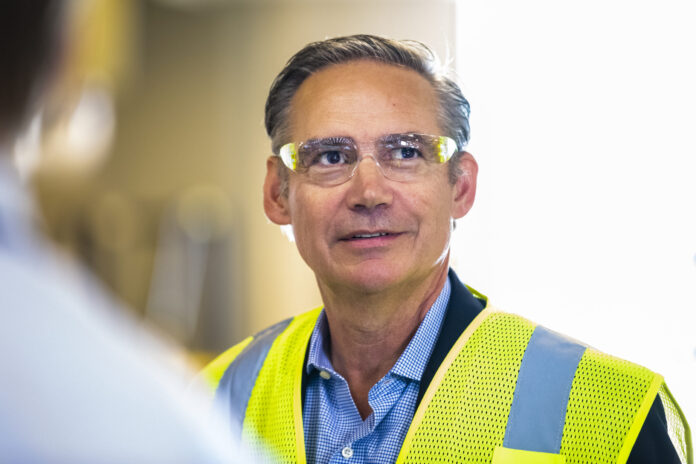By Scott Hamilton
Feb. 20, 2025, © Leeham News: Boeing hopes to certify its largest aircraft, the 777-9, late this year or early next year so that it can finally begin delivery of the 425-seat aircraft.
Delivery was originally supposed to be in December 2019 or the following quarter. However, technical delays, including those with the giant 115,000 lb thrust engines from GE Aerospace and the negative halo effect from the 737 MAX crisis, resulted in this unusually long delay.
Kelly Ortberg, Boeing’s CEO, reaffirmed the certification and delivery hopes during his first appearance since taking his job last August at an investment bank’s investor conference.
“We’re going through the flight test program, and we’re planning to get the certification done towards the end of this year or early next year so we can start the delivery,” Ortberg told the Barclays Bank event today. “The challenge is we’ve got to get through the certification here on the Dash 9 to start delivering these things to our customers.
“I was just with Carson Spohr, the CEO of Lufthansa. He impressed upon me how critical that airplane is to his operating model,” Ortberg said.
The program is in a reach forward loss, so Ortberg said that any additional schedule delay with the program will likely result in another loss. Over the life of the program, he says it’ll be a profitable airplane.
Certification process
Certification of the 777X isn’t the only airplane stalled in the process. The 737-7 and 737-10 also are years behind certification due to the crisis that erupted following two accidents in 2018-19 of the 737-8 that killed 346 people. The ensuing investigation revealed irregularities in the airplane certification between Boeing and the Federal Aviation Administration that still reverberates.
“One of the things that I’m going to focus on with…the team this year is the certification process. We’ve got the Dash 9, and then the two variants of the MAX that still have to get through certification, and a lot of change is going on with the FAA leadership,” Ortberg said.
“We’re trying to be very proactive. I’m meeting with the [new] Transportation Secretary. We’re going to get him out to Seattle. We’ve got the new interim FAA administrator coming to Seattle to make sure we don’t have any misalignment as we go through leadership changes there with the FAA. We have a pretty good plan on the rate increases. I don’t anticipate the administration change is going to impact us in that.”
Returning to higher production rates
The FAA capped the 737 production rate at 38/mo a year ago as Boeing worked through safety and quality control issues in the factory. But throughout 2023 and 2024, Boeing was stuck producing new 737s in the high teens or low 20s per month. Reasons included Boeing’s internal problems and continuing external supply chain issues, especially with Spirit AeroSystems, which makes the fuselages. Spirit’s QC problems have diminished, and Boeing will assume ownership of the Spirit Boeing work later this year.
Still, Ortberg is optimistic that the company will achieve a rate of 38 later this year.
“Things look really, really good. The supply chain on 737 is in good shape. We don’t have any supply chain constraints right now that I see that are going to stop us from ramping up here to the 38 a month. That’s where we have the FAA cap that we’ve got to get through this year,” Ortberg said.
“Our metrics are tracking really well to allow us to do that. But it’s early innings, so we’ve got to stay focused on this and stay disciplined. One of the things that I think we really are benefiting from, both in the supply chain and our own production work, is during the [53-day IAM] strike [last fall], we didn’t waste that time.
“We did go clean the inventory, get the production system cleaned out, and rebalanced. We’ve just got to stay disciplined to make sure it stays that way as we ramp back up,” he said.
787 program
Boeing ended 2024 at a production rate of 5/mo, a year behind schedule. Supply chain delays, notably on seats, and certification of business class interiors have been perpetually troubled spots.
Ortberg said Boeing wants to increase this rate to 7-8/mo, but some quality milestones must still be met first.
“That creates some challenges for our customers because it’s fewer airplanes than if we went faster,” he said. “But I think it’s much more important that we deliberate here and do it the right way than try to go fast and let our production system get unstable again.”
Ortberg said there is a shortage of heat exchangers that go into the 787’s engines, causing delivery delays. “That’s an issue that came out of the Russia-Ukraine conflict, and we had to move production in our supply chain,” he said. “They’re not exactly where we’d want them to be, but they’re making good progress to get there. I don’t think the heat exchangers will be a problem for us to move from five to seven.”
Seats continue to be a problem, but it’s not production. “It’s getting the seats certified. It’s not the butt part of the seat. It’s the cabinet and the doors for first class and business class,” he said.
“These are pretty complex systems, and getting those certified has taken both the seat suppliers and us longer than anticipated. If you were in Charleston [where the 787s are assembled], you’d see we’ve got completed airplanes that are held up for delivery for the seats, which obviously go in pretty late in the assembly process. That’s something we’re going to continue to work through, but it’s generally only if it’s a first-of-type seat.”
Related


